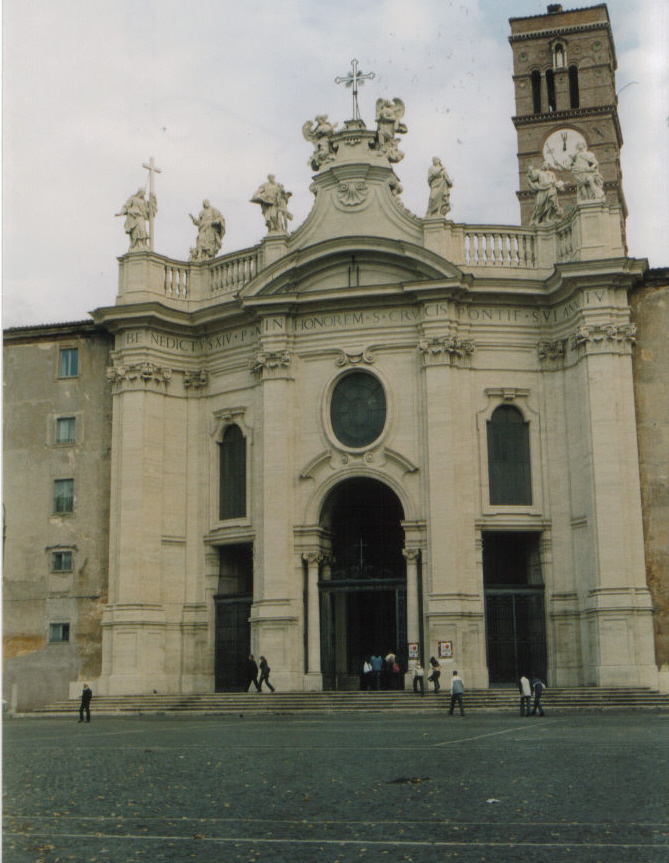- Santa Croce in Gerusalemme
Infobox church
name = Santa Croce in Gerusalemme
fullname =Basilica di Santa Croce in Gerusalemme

imagesize =
caption = Facade
landscape =
denomination = Roman Catholic
diocese = Rome
parish =
division =
subdivision =
founded_date =
founder =
architect =
style = Baroque
constructed_date =
dedicated_date = ca.325
closed_date =
demolished_date =
bishop = Miloslav Cardinal Vlk
priest =
archdeacon =
dean =
provost =
rector =
canon =
prebendary =
curate =
chaplain =
vicar =
deacon =
abbot =
minister =
seniorpastor =
pastor =
country = flagcountry|Italy
phone =
website = http://www.basilicasantacroce.it/Santa Croce in Gerusalemme is a
basilica inRome . It is one of theSeven Pilgrim Churches of Rome .According to tradition, the basilica was consecrated around
325 to house the Passion Relics brought to Rome from the Holy Land by St.Helena of Constantinople , mother of Constantine I. At that time, the basilica floor was covered with soil fromJerusalem , thus acquiring the title "in Hierusalem".The current
Cardinal Priest of the "Titulus S. Crucis in Hierusalem" is Miloslav Vlk.History
The church is built around a room in St. Helena's imperial palace, "Palazzo Sessoriano", which she adapted to a chapel around the year 320. Some
decennia later the chapel was turned into a true basilica, called "Heleniana" or "Sessoriana". After falling into neglect, the church was restored byPope Lucius II (1144-1145). In the occasion it assumed a Romanesque appearance, with three naves, a belfry and a porch.The church was also modified in the
16th century , but it assumed its current Baroque appearance under Benedict XIV (1740-1758). New streets were also opened to connect the church to the two other Roman basilicas linked to Jesus' life,San Giovanni in Laterano andSanta Maria Maggiore . The façade of Santa Croce, designed byCorrado Giaquinto andDomenico Gregorini , shares the typical late RomanBaroque taste with the former basilicas.Passion relics
The famous relics, whose authenticity is disputed, are now housed in a Chapel (the "Cappella delle Reliquie"), built in
1930 by architect Florestano di Fausto. They include: a part of the "Elogium" orTitulus Crucis , i.e. the panel which was hanged to the Christ's Cross; two thorns of his crown; an incomplete nail; and three small wooden pieces of theTrue Cross itself. A much larger piece of the holy cross was brought from Santa Croce in Gerusalemme toSt. Peter's Basilica on instruction ofPope Urban VIII in the year 1629. It is kept nearby the statue of St. Helena, completed byAndrea Bolgi in1639 . In Santa Croce there are also a finger of St. Thomas and fragments of the grotto ofBethlehem .Relics enshrined at Santa Croce in Gerusalemme in the Chapel of the Holy Relics include:
*A large fragment of the Good Thief's cross;
*The bone of an index finger, said to be the finger of St. Thomas that he placed in the wounds of the Risen Christ
*A single reliquary containing small pieces of: the Scourging Pillar (to which Christ was tied as he was beaten); the Holy Sepulchre (Christ's tomb); and the crib of Jesus
*Two thorns from the Crown of Thorns. It is said that the plant from which these came is a species of thornbush that only grows in present day Israel.
*Three fragments from the True Cross
*One nail used in the Crucifixion.
*One third of the Title of the Cross, discovered in the church in 1492. The fragment shows the word "Nazarene" written in Hebrew, Latin and Greek.Chapel of St. Helena
The relics were once in the ancient "St. Helena's Chapel", which is partly under ground level. Here the founder of the church had some earth from
Calvary dispersed, whence the name "in Hierusalem" of the basilica. In the vault is a mosaic designed byMelozzo da Forlì (before 1485), depicting "Jesus Blessing", "Histories of the Cross" and various saints. The altar has a huge statue of St. Helena, which was obtained from an ancient statue of Juno discovered at Ostia. Mediaeval pilgrim guides noted that the chapel was considered so holy, that access to the chapel by women was forbidden.Other artworks
The apse of church includes frescoes telling the "Legends of the True Cross", attributed to Melozzo, to
Antoniazzo Romano andMarco Palmezzano . The Museum of the Basilica houses a mosaicicon from the14th century : according to the legend,Pope Gregory I had it made after a vision of Christ. Notable is also the tomb of CardinalFrancis Quinoñes , byJacopo Sansovino (1536 ).Peter Paul Rubens , who had arrived in Rome by way ofMantua in1601 , was commissioned by Archduke Albert of Austria to paint an altarpiece with three panels for the chapelSt. Helena . Two of these paintings, "St. Helena with the True Cross" and "The Mocking of Christ", are now inGrasse ,France . The third, "The Elevation of the Cross", is lost. Before his marriage, the archduke had been made a cardinal in this church.References
*Paolo Coen, "Le Sette Chiese", Newton Compton, Rome
*Claudio Rendina, "La grande Enciclopedia di Roma", Netwon Compton, Rome
*Kristin Lohse Belkin, "Rubens", London: Phadon (1998): 63-66. ISBN 0-7148-3412-2External links
* [http://www.basilicasantacroce.com/ www.basilicasantacroce.com] - official website
Wikimedia Foundation. 2010.
